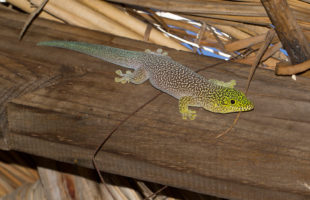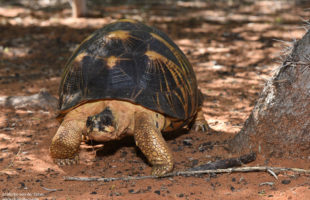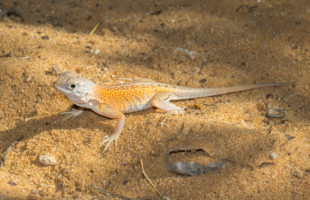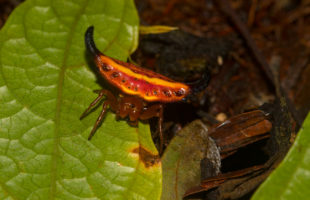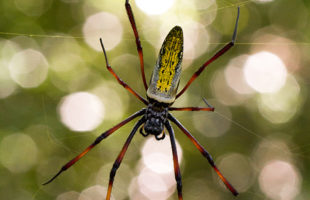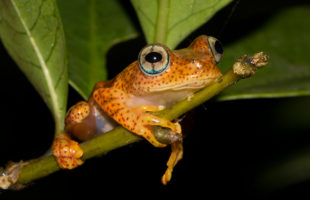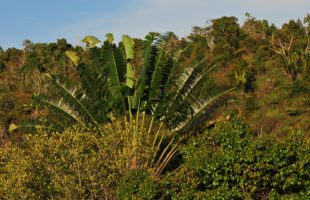In southwest Madagascar, between spiny forests and wooden huts, lives a gecko with triking colours: Standing’s Day Gecko (Phelsuma standingi). Who visits the dry, hot area between Morombe, Toliara (French Tuléar) and the national park Isalo, will sooner or later meet this beautiful reptile. It originally lives in dry and spiny forests, but today – contrary to many other, outdated …
LesenClad in armour but hardly protected: The Radiated Tortoise
They have not changed for millions of years and still fascinate people all over the world: tortoises. A particularly beautiful species lives in the south of Madagascar: the Radiated Tortoise (Astrochelys radiata). Its history begins long, long before the first people came to Madagascar. But it was not until 1802 that the Englishman George Shaw described the Radiated Tortoise. He …
LesenLife in drought and heat – The Malagasy collared lizard
Only few animals can survive in Madagascar’s dry, hot south for long. One of them is the Madagascar sand lizard (Chalarodon madagascariensis). Madagascar has no large iguanas like you probably know iguanas from America. Instead the local iguanas are rather small, agile and swift – they are so special, that they got their own family, which exists nowhere else on …
LesenLife in colour: panther chameleons
Panther chameleons (Furcifer pardalis) belong to the most famous inhabitants of Madagascar and regularly populate the coastal areas of northwest Madagascar, across the north and on the east coast down to about 120 kilometres south of Toamasina (Tamatave). There seem to be no particular favourites among the populated habitats, even if one sees them particularly well in open, bush-covered areas. …
LesenThe Malagasy Tree Boa
Saying of many ages and fairy tales she has a dubious reputation, but actually she is a fascinating forest dweller: The Malagasy Tree Boa. There are two species of Tree Boa in Madagascar. The species Sanzinia madagascariensis lives mainly in the rainforests of the east coast of Madagascar. The second species, Sanzinia volontany, has conquered other habitats such as the …
LesenNo fear of tiny spines
Rainforests are their home: Tiny, colorful, spiny creatures in spider webs. These are spiny orb weavers, and they do not really fit into the concept of a scary, quickly moving eightlegged spider. Their unusually shaped belly part does not look scary at all. In contrast to normal spiders, they even move rather slowly and ponderously, you might almost find them …
LesenThe Red-legged Golden Orb-web Spider
Most travelers are more frightened by the sight of a spider, but the Red-Legged Golden Orb-Web Spider (Trichonephila inaurata madagascariensis) can teach some people otherwise. The female, including her legs, is as big as a human hand, the body is black with a golden-yellow, white-grey lined stripe on the back, the legs are broadly striped in black and red. The …
LesenThe not really fiery red frog
Madagascar’s dense, mystical rainforests offer a home to countless endemic (i.e. only here occurring) animals. Among them is a particularly colorful representative of the Madagascar frogs, a frog with the scientific name Boophis pyrrhus (from Greek pyrrhos = fire red). It can be found on the east coast and in the southern highlands of Madagascar, from Soanierana Ivongo near the …
LesenThe angels of the forest: Silky sifakas
The Silky Sifaka (Propithecus candidus) is one of the most beautiful and special lemurs of Madagascar, but also one of the rarest. There are only about 250 sexually mature silk sifakas left in Madagascar, otherwise they do not occur anywhere else in the world. For comparison: In Asia alone there are still around 3000 to 5000 full-grown specimens of tigers …
LesenThe Tree of Travelers
The Ravenala, better known as the tree of travelers, belongs to the strelitzia family, despite resembling a palm tree. Although it is now common all over the world and is even cultivated as an ornamental plant in some homes, it originated in Madagascar and only occurs naturally there. Ravenalas grow from six to thirty meters and are particularly known for …
Lesen MADAMAGAZINE Your Magazine about Madagascar
MADAMAGAZINE Your Magazine about Madagascar
